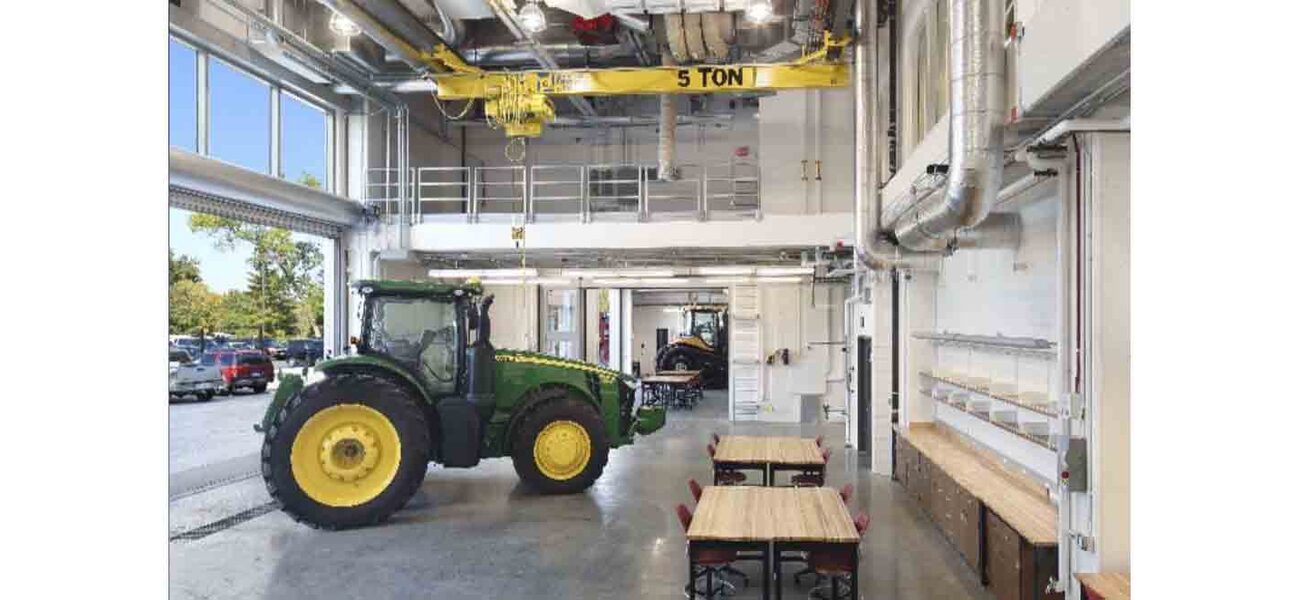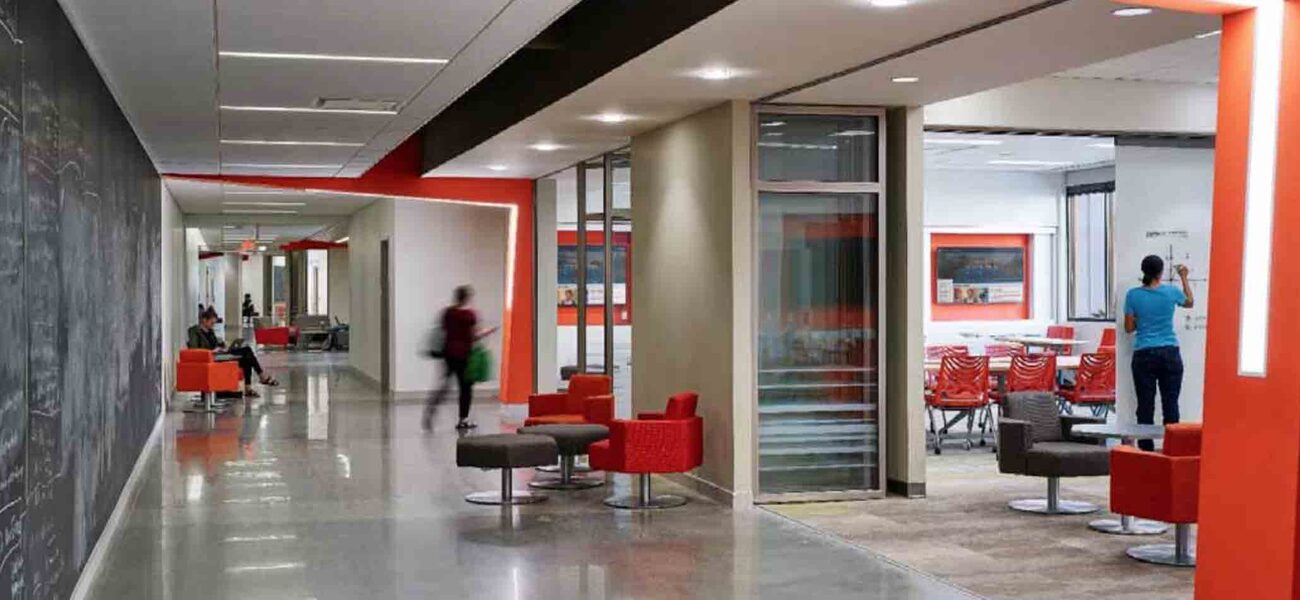Universities and businesses have worked together for decades. Today, changes in funding and in STEM career paths have made those partnerships more attractive than ever—so attractive, in fact, that many institutions are planning new spaces specifically for them. With limits on government funding in recent years, and state and local funding stagnant, many institutions are seeing 25 to 30 percent of their research funding coming from outside sources, primarily private industry. That has led to more elaborate and specific consideration of industry partnerships as a part of strategic planning.
“Part of the establishment of certain research institutes is that they will achieve 30 percent, 50 percent, or more of their external funding within a certain number of years,” explains Jill Swensen of Stantec Architecture. She and colleague Gene Kluesner, both principals at Stantec, have been studying the partnership phenomenon.
Swensen and Kluesner found that as much as 30 percent of graduate hiring comes from these partnerships, often created under the National Science Foundation’s Industry-University Collaborative Research Center (IUCRC) program. “For every dollar they put into these seed funds, they are getting four dollars back in terms of the effect of research activity that is happening with these collaborations,” says Swensen.
The advantages are many:
- Students get access to research and work opportunities in STEM fields, even as undergraduates.
- Industry partners have access to new talent and a pipeline to bring in new employees from those they have already seen working and solving real problems.
- Students have access to coaching and mentorship opportunities that can lead to innovative new businesses.
- Industry and universities can collaborate on programs to create expertise in needed fields.
- Industry and universities can work together toward common goals, such as re-energizing a dormant local economy.
- Engagement in collaborative projects helps improve student retention.
For instance, at Santa Clara University, participation in an IUCRC in sustainable engineering systems has helped inspire a Frugal Innovation Lab that uses technology to solve humanitarian problems in collaboration with industries and nonprofits. The results, such as a breast milk sensor to detect E. coli bacteria in donated milk, support the Jesuit school’s underlying mission of using ingenuity to do more with less.
Lloyd Fisk, principal at Research Facilities Design in San Diego, and his colleague, laboratory consultant John Lewis, have worked on many projects involving such partnerships, and divide them into five basic types:
- Industry funding researchers’ work
- Researchers’ work and intellectual property becoming a startup
- Industry paying for use of core labs owned by a university
- Industry leasing incubator space in an academic facility
- Industry developing pedagogical programs in collaboration with academia
As an example of the first model, they note a project at the University of Kentucky, where the Center for Applied Energy Research, originally all government-funded, grew into a partner with industry as its work began to show promise of converting waste products (sawdust and coal fines) into biofuels. Meanwhile, the solar research group is collaborating with 3M to pursue cheaper solar film, while the engineering department has such a strong relationship with the nearby Toyota plant that UK’s anechoic test chamber was designed with wide pathways for Toyota trucks to be driven in for testing. “It is a pay-per-use facility that Toyota uses quite liberally, from my understanding,” says Lewis.
What Does this Mean for Building and Renovating Spaces?
While many partnerships are small and grow out of existing labs and needs, university planners need to bear them in mind when designing and planning new or renovated spaces. Kluesner and Swensen offer several considerations for such projects, many of which reflect existing trends in scientific and academic spaces:
- Flexible and modular spaces
- Room for projects and competitions
- Cross-disciplinary spaces specifically devoted to innovation (“It is the problem that binds you, not the college or discipline,” says Kluesner.)
- Investment in technology
- Amenity-rich spaces with walkable routes and intentional engagement spaces that foster natural interactions
“Over the last 10 years, we have been developing these unscheduled, informal collaboration spaces along corridors, in lobbies, in different areas in buildings, and we are measuring it because it is usable program space that is active and does support the program components,” says Swensen.
All this can lead to some unusual configurations, such as the one at George Brown College in Toronto, where a new building intentionally brings together maker spaces, dorms, a robotics program, and other innovation-related programs.
One strategy Stantec has implemented is to make various lab utility connections available to various flexible spaces in a building, without actually connecting them until the inhabitants decide they need them. Another is to make some spaces “storefronts,” where innovators can test-market consumer products.
On a more mundane level, Fisk notes that partnerships need to address the issue of parking, which is already scarce on many campuses. Industry partners expect parking for their executives and employees. Incubator and lab spaces need fume hoods, and planning for appropriate air circulation is a given with science projects. Lewis says designers need to consider not only current fume hood needs, but also the possibilities for future capacity as the use of the space changes over time.
A Few Case Studies
One project Stantec has under way is the design for a multiblock “BioQuarter” in Edinburgh, which will combine space for industry partners, National Health Service offices, University of Edinburgh Medical School teaching and research space, and arts and exercise areas, as well as housing, retail, and a hotel. The master plan includes parks and a new waterway to entice people to walk around the zone, and pedestrian and public transit links to other parts of the city.
Further south in Manchester, England, an Interdisciplinary Biocentre bringing the University of Manchester together with biotech companies has been going for 10 years, producing eight patents, 12 licensed products, and thousands of published scientific papers. “In their minds, this is a big success,” says Swensen. The project, which also involved Stantec, involves a series of flexible labs that can be open or subdivided, wrapped around core technology areas, which can be shared or dedicated to the adjacent lab. Flanking the labs are meeting spaces and offices, and the ground floor provides access to public program areas, a large eating space, and retail shops.
Fisk and Lewis point to a project at the University of Wyoming, where a high-bay research facility was constructed with financial and collaborative input from the oil and gas industry. “The facility accommodates very complex equipment that supports high-end analysis in these extraction technologies. Indeed, it has probably created one of the most advanced institutional research facilities of its type in the world,” says Fisk. “A lot of this is very high-end equipment; many of these pieces of equipment cost many millions of dollars each. They are either donated or funded through agreements with those industry partners.”
Important Considerations
One potential drawback to industry-university pairings is that many industries are cyclical and volatile. The big tech company that is funding research and renting space today may have to pull back tomorrow. Academic and corporate institutions need to plan for potential issues by establishing solid agreements and diversifying their innovation investments.
At UC Berkeley, for example, a partnership with oil company BP was controversial from the start on the liberal campus, and while it produced useful research for years, it became a bit of an issue when oil prices dropped and BP had to withdraw some of its funding. “Perhaps there is a story there about putting too many eggs in one basket, giving someone a whole floor that really isn’t designed to be subdivided if things change over the course of time,” comments Fisk.
Another is that most corporate partners won’t just show up and decide to help build a new building. Most of the major projects in this area include multiple partners on both the industry and university sides, often building on relationships that take years to establish and nurture. “(Companies) are going to test and try you out, and then it just keeps building,” explains Kluesner.
Location is an important driver for partnerships and helps determine the shape those collaborative programs will take. “There is a geographic reason that all of these facilities developed. There is almost always a very close linkage to industry in a specific region that led these projects to exist,” says Fisk. A project in a rural state might include incubator space, as was done at the University of West Virginia, while a project in Boston, where such space is abundant, need not do so.
It’s not enough just to have a well-designed physical space. Universities and industrial partners need to collaborate on programs and develop a shared understanding of the outcomes they want from their collaboration. The programs need regular energy and leadership to get the most out of the relationship, including deciding how to handle safety and risk, what financial responsibilities exist, and how the stakeholders will handle intellectual property resulting from their work. Fisk says, “A lot of it comes down to relationships.”
By Patricia Washburn

